Hokkaido and more
- Sort by
- Popularity
- Name
-
Kamakura-bori lacquerware Kamakura bori
- Lacquerware
- Kanagawa
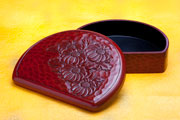
Kamakura-bori is a type of lacquer ware made in the area around the city of Kamakura in Kanagawa prefecture. The tradition dates back to the Kamakura period (1185-1333) when Tsuishu and Tsuikoku, thickly lacquered wooden wares, were imported from …
View more
-
Hakone wood mosaic Hakone yosegi zaiku
- Wood, bamboo crafts
- Kanagawa
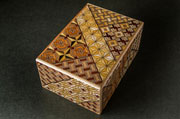
Hakone yosegi zaiku is a form of marquetry produced in the town of Hakone, Kanagawa prefecture, an area renowned for having the most natural environment in Japan. For this reason, there is a rich variety of tree species found on Mt. Hakone. Such a…
View more
-
Iga ware Iga yaki
- Ceramic
- Mie
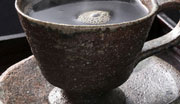
Iga ware (called iga yaki in Japanese) is a form of porcelain produced in the area around the city of Iga, Mie prefecture. The main production areas of this craft are the sites of Makiyama and Marubashira in the Ayama district of Iga and the excel…
View more
-
Tsuboya ware Tsuboya yaki
- Ceramic
- Okinawa
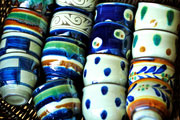
Tsuboya ware (called Tsuboya yaki in Japanese) is a form of pottery produced mainly in Tsuboya, city of Naha, Okinawa prefecture. This craft is one of the leading representations of Okinawan pottery (yachimun in the Okinawa dialect). The notable f…
View more
-
Boshu uchiwa fans Boshu uchiwa
- Other crafts
- Chiba
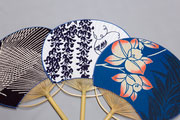
Boshu uchiwa is a type of fan made in the areas around the cities of Tateyama and Minamiboso in Chiba prefecture. This is one of Japan’s big three uchiwa types, with the other two being Marugame (Kagawa prefecture) and Kyo uchiwa (Kyoto prefecture…
View more
-
Miyako ramie textile Miyako jofu
- Woven textiles
- Okinawa
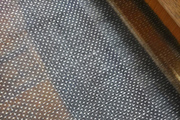
Miyako jofu is a textile produced on the island of Miyakojima, Okinawa prefecture. It is woven from a fabric called ramie and dyed with Ryukyu indigo, a type of indigo native to Okinawa. This textile has a fine kasuri pattern* and a smooth and lu…
View more
-
Ryukyu lacquerware Ryukyu shikki
- Lacquerware
- Okinawa
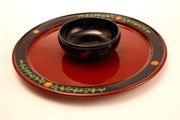
Ryukyu lacquerware (called Ryukyu shikki in Japanese) is produced in Okinawa prefecture. Lacquerware techniques imported from China were well-adapted during the development of Ryukyu lacquerware unique to Okinawa. The technology and artistry invol…
View more
-
Kumejima tsumugi silk Kumejima tsumugi
- Woven textiles
- Okinawa
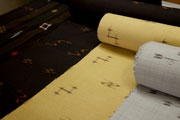
Kumejima tsumugi silk is a textile produced on the island of Kumejima, Okinawa prefecture. The history of this craft goes back all the way to the Muromachi period (1336-1573). This textile is distinct because of its elegant texture and deep color …
View more
-
Ryukyu traditional resist-dyed textiles Ryukyu kasuri
- Woven textiles
- Okinawa
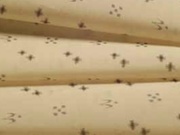
Ryukyu kasuri is a textile made in Okinawa prefecture. It is made mostly from silk and dyed with both plant and synthetic dyes using a kasuri* or resist-dyeing technique. This craft features over six hundred different kinds of patterns inspired by…
View more
-
Banshu abacus Banshu soroban
- Writing tools
- Hyogo
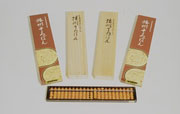
Banshu abacuses (called Banshu soroban in Japanese) are produced in the city of Ono, Hyogo prefecture. Ono, an agricultural area blessed with a warm climate, started abacus production during its off-season. Japanese abacuses are traditional tools…
View more
-
Suzuka inksticks Suzuka sumi
- Writing tools
- Mie
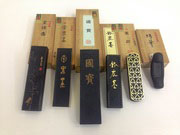
Suzuka inksticks (called Suzuka sumi in Japanese) are made in the city of Suzuka, Mie prefecture. This is the only inkstick craft registered as a Traditional Japanese Craft. Just one company, Shinseido, continues to produce Suzuka inksticks. This …
View more
-
Tamba-tachikui ware Tamba tachikui yaki
- Ceramic
- Hyogo
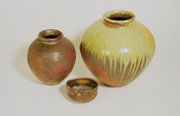
Tamba-tachikui ware (called Tamba-tachikui yaki in Japanese) is a form of pottery produced around Konda in the city of Sasayama, Hyogo prefecture. It is one of Japan's Six Ancient Kilns. Together with Bizen, Tamba, Echizen, Seto, and Tokoname…
View more
-
Yokkaichi-banko ware Yokkaichi banko yaki
- Ceramic
- Mie
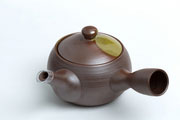
Yokkaichi banko ware (called Yokkaichi banko yaki in Japanese) is a form of ceramic ware produced in the city of Yokkaichi, Mie prefecture. For a long time, items for everyday use like teacups and plates, as well as pieces of art like vases have b…
View more
-
Izushi ware Izushi yaki
- Ceramic
- Hyogo
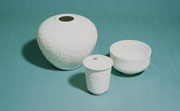
Izushi ware (called
View more
-
Chibana-hanaori textiles Chibana hanaori
- Woven textiles
- Okinawa
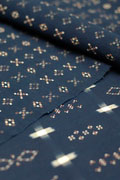
Chibana hanaori is a textile produced in Chibana, Okinawa, Okinawa prefecture. It has flowery patterns woven in the base textile as well as a continuous geometric pattern. This kind of textile with a continuous geometric pattern is called mon orim…
View more
-
Odawara lacquerware Odawara shikki
- Lacquerware
- Kanagawa
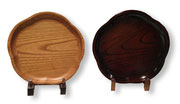
Odawara lacquerware (called Odawara shikki in Japanese) is a type of lacquerware that is made in the city of Odawara, Kanagawa prefecture. It features a glossy lacquer finish which highlights the elegant grain of the wood material. While beautiful…
View more
-
Yaeyama cotton cloth Yaeyama minsa
- Woven textiles
- Okinawa
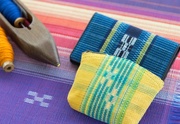
Yaeyama minsa is a fabric produced in the town of Taketomi, Yaeyama district and the city of Ishigaki, Okinawa prefecture. The origin of this craft is not clear but it is thought that the kasuri belt was brought to Okinawa from Afghanistan via Chi…
View more
-
Yaeyama ramie cloth Yaeyama jofu
- Woven textiles
- Okinawa
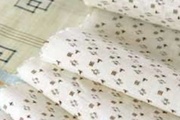
Yaeyama jofu is a fabric produced in the area surrounding Yaeyama ward in Ishigaki city, Okinawa prefecture. This textile is woven with hand-spun ramie threads and used to be produced as a tax to the Ryukyu Kingdom (present day Okinawa) in ancient…
View more
-
Shuri brocade Shuri ori
- Woven textiles
- Okinawa
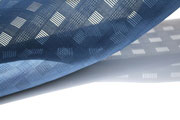
Shuri brocade (called Shuri ori in Japanese) is a woven fabric produced on the main island of Okinawa. There are two types of fabric, kasuri orimono and mon orimono, and these include hanaui, hanakura ori, doton ori, kasuri and minsa. The Ryukyu …
View more
-
Yomitanzan-hanaori textiles Yomitanzan hanaori
- Woven textiles
- Okinawa
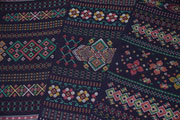
Yomitanzan hanaori is a textile produced in the village of Yomitan, Okinawa. The threads of this craft are first dyed before being woven in a geometric, flowerlike design. This craft is woven with silk or cotton threads dyed with plant-based dyes …
View more
-
Iga braided cords Iga kumihimo
- Other textiles
- Mie
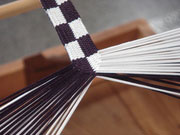
Iga Braided Cords, called Iga Kumihimo in Japanese, are made in Mie prefecture. Mainly silk threads are used, often in combination with gold and silver threads. This craft is known for rich silk threads, being dyed in a vibrant range of colors, an…
View more
-
Nibutani carved wooden tray Nibutani ita
- Wood, bamboo crafts
- Hokkaido
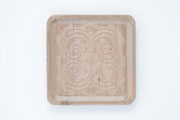
Nibutani Carved Wooden Trays (called Nibutani ita in Japanese) are produced in Biratori, Hokkaido. The origin of the town name, is an Ainu language word for cliff, pirauturu. This craft is known for its patterns like a spiral pattern called moreun…
View more
-
Ise paper stencil printing Ise katagami
- Industrial art materials and tools
- Mie
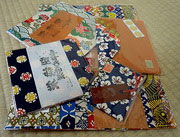
The Japanese name of Ise Paper Stencil Printing is Ise Katagami. Katagami means paper stencil. Today this craft is mostly produced in the city of Suzuka in Mie prefecture. They are an important part of textile dyeing. For many years, such stencils…
View more
-
Nibutani bark cloth Nibutani attoushi
- Woven textiles
- Hokkaido
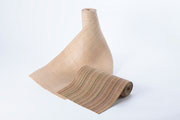
Nibutani Bark Cloth (called Nibutani-attushi in Japanese) is a bark fiber fabric produced in the region surrounding the the town of Biratori, Hokkaido. The term Nibutani originates from niputai which is an Ainu (indigenous people of north Japan) l…
View more
-
Ryukyu traditional textiles Ryukyu bingata
- Dyed textiles
- Okinawa
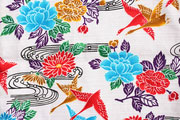
Ryukyu Bingata is a dyed and woven textile produced around Shuri, Okinawa prefecture. Its origin goes back to the 14th to 15th century. The ladies of the royal family or the families of the warrior class wore Ryukyu Bingata. There are two kinds of…
View more
-
Banshu fly-fishing flies Banshu kebari
- Other crafts
- Hyogo
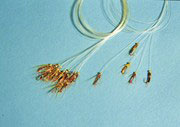
Banshu Kebari are fishing flies used as artificial-bait hooks for fishing, produced in Nishiwaki City, Hyogo Prefecture. They are characterized by their exquisitely fine workmanship; bird feathers wound with silk thread around a small 1cm hook, ad…
View more
-
Banshu-miki cutlery Banshu miki uchihamono
- Metal works
- Hyogo
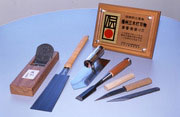
Banshu Miki Uchihamono are metalwork produced around Miki City, Hyogo Prefecture. Like Shinshu Uchihamono and Tosa Uchihamono, Banshu Miki Uchihamono is renowned as a craft made using molding techniques. These areas are also known as large product…
View more
-
Toyooka wicker crafts Toyooka kiryu zaiku
- Wood, bamboo crafts
- Hyogo
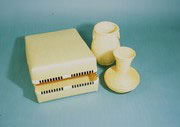
Toyooka Wicker Crafts, called Toyooka Kiryu Zaiku in Japanese, is wickerwork produced around Toyooka City, Hyogo Prefecture. The origins of the craft are found in the baskets woven from Salix koriyanagi, a species of willow naturally growing in th…
View more
-
Kijoka banana fiber cloth Kijoka no bashofu
- Woven textiles
- Okinawa
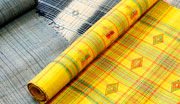
Kijoka no Bashofu are a woven cloth produced in Kijoka, Ogimi Village in northern Okinawa. Bashofu is made from the fibers of the Japanese banana plant called Basho, and has been used to make kimonos in Okinawa since ancient times. Kijoka no Basho…
View more
-
Yonaguni brocade Yonaguni ori
- Woven textiles
- Okinawa
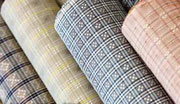
Yonaguni Brocade, called Yonaguni Ori in Japanese, is a textile produced in Yonaguni-cho, Yaeyama Gun, Okinawa Prefecture. The characteristic of Yonaguni Ori is the simple beauty of the textile that is dyed and woven by hand in the distinctive cli…
View more

































































































































































































































































































